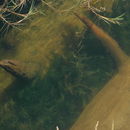Comments
provided by eFloras
Potamogeton robbinsii is our most easily recognized species when it is fertile. It is the only species with branched inflorescences. The species, however, occurs in fairly deep water, forming large colonies that essentially cover the substrate. Only rarely do the plants flower. It also is the only species with truly auriculate leaves, the blades forming small lobes projecting past the stem on each side of the stem. Leaf blades of other Potamogeton species may have slightly rounded bases, but no others have lobes that actually protrude past the stem.
The species has a fairly large disjunction; primarily known from the northern part of the flora, it also occurs in the Tensas River area, Baldwin County, Alabama. The Alabama population has been collected on at least two occasions over 40 years, once as recently as 1970.
- license
- cc-by-nc-sa-3.0
- copyright
- Missouri Botanical Garden, 4344 Shaw Boulevard, St. Louis, MO, 63110 USA
Description
provided by eFloras
Rhizomes present. Cauline stems terete, without spots, to 100 cm; glands absent. Turions absent. Leaves submersed, conspicuously 2-ranked, sessile, stiffish; stipules persistent, conspicuous, adnate to base of blade about ± ¼ length of stipule, connate, greenish brown to white, ligulate, 0.5--2 cm, fibrous, shredding at tip, apex obtuse; blade dark green to reddish green, linear to lanceolate, not arcuate, 2--7(--12) cm ´ 3--4(--8) mm, base rounded, with basal lobes, not clasping, margins minutely spinulose to serrulate, not crispate, apex not hoodlike, acute, lacunae absent; veins 20--60, fine. Inflorescences often branched; peduncles not dimorphic, axillary, erect, cylindric, 3--5(--7) cm; spikes not dimorphic, moniliform (i.e., beaded), 7--20 mm. Fruits stipitate, brown, obliquely obovoid, turgid, abaxially and laterally keeled, 3--4(--5) ´ 2(--3.3) mm, lateral keels without points; beak erect, recurved at apex, 0.7--0.9 mm; sides without basal tubercles; embryo with less than 1 full spiral. 2n = 52.
- license
- cc-by-nc-sa-3.0
- copyright
- Missouri Botanical Garden, 4344 Shaw Boulevard, St. Louis, MO, 63110 USA
Distribution
provided by eFloras
Alta., B.C., Man., N.B., N.W.T., N.S., Nunavut, Ont., P.E.I., Que., Sask.; Ala., Alaska, Calif., Conn., Idaho, Ill., Ind., Maine, Mass., Mich., Minn., Mont., N.H., N.J., N.Y., Ohio, Oreg., Pa., R.I., Utah, Vt., Wash., Wis., Wyo.
- license
- cc-by-nc-sa-3.0
- copyright
- Missouri Botanical Garden, 4344 Shaw Boulevard, St. Louis, MO, 63110 USA
Flowering/Fruiting
provided by eFloras
Flowering late summer--early fall.
- license
- cc-by-nc-sa-3.0
- copyright
- Missouri Botanical Garden, 4344 Shaw Boulevard, St. Louis, MO, 63110 USA
Habitat
provided by eFloras
Shallow to deep water of ponds, lakes, and slow-flowing rivers; 0--3000m.
- license
- cc-by-nc-sa-3.0
- copyright
- Missouri Botanical Garden, 4344 Shaw Boulevard, St. Louis, MO, 63110 USA
Comprehensive Description
provided by North American Flora
Potamogeton robbinsii Oakes, Mag, Hort. Hovey 7 : 180. 1841
Stem slender, branched and sometimes rooting at the nodes ; leaves all submerged, linear, minutely serrulate throughout, 8-13 cm. long, 2.5-4 mm. wide, apiculate or acute at the apex, somewhat clasping at the base, many-nerved ; stipules adnate to the leaf-bases, the sheath 1-1.5 cm. long, the free part longer ; peduncles 3-10 cm, long, usually branched, a little thinner than the stem ; spike slender, 1-2 cm. long, many-flowered but sparinglyfruited ; nutlets slightly pitted, 3-keeled, the middle keel larger than the lateral ones ; embryo a complete or incomplete spiral, the apex pointing directly towards the base or inside it.
Type locality : New Hampshire.
Distribution: Maine to British Columbia, south to Pennsylvania, and Washington.
- bibliographic citation
- Percy Wilson, Per Axel Rydberg, Norman Taylor, Nathaniel Lord Britton, John Kunkel Small, George Valentine Nash. 1909. PANDANALES-POALES; TYPHACEAE, SPARGANACEAE, ELODEACEAE, HYDROCHARITACEAE, ZANNICHELLIACEAE, ZOSTERACEAE, CYMODOCEACEAE, NAIADACEAE, LILAEACEAE, SCHEUCHZERIACEAE, ALISMACEAE, BUTOMACEAE, POACEAE (pars). North American flora. vol 17(1). New York Botanical Garden, New York, NY
Potamogeton robbinsii
provided by wikipedia EN
Potamogeton robbinsii, commonly known as Robbins' pondweed, is a North American perennial herb. The specific epithet robbinsii is named in honor of James Watson Robbins, the pioneer student of the genus.
It is found in deep to shallow, quiet, often muddy waters of lakes, ponds, and rivers.[1]
Description
The rootstock of Potamogeton robbinsii lacks tubers. The stems root from the lower nodes, and sterile stems are either simple or widely branching and are feather-like, covered with sheathing whitish stipules. The sterile stems measure 10–90 cm (3.9–35.4 in) long. Flowering stems grow up to 2 m (6 ft 7 in) tall. Leaves on the sterile stems are linear, stiff, and grow opposite on the stem, measuring 3–8 mm (0.12–0.31 in) long. Leaves are densely crowded on sterile stems, are auricled at their base, and have a minutely serrated margin. The tip of the fibrous pale stipule is as long or longer than its sheath. Leaves born on flowering stems are remote and reduced, with stipules with shorter tips. The branching inflorescence bears one to twenty-six straight peduncles with stiff and interrupted spikes that grow .7–2 cm (0.28–0.79 in) long. The plant fruits rarely, with flattened fruit that measures 4–5 mm (0.16–0.20 in) long and 2.7–3.3 mm (0.11–0.13 in) wide. The fruit has a prominent keel with an approximately central beak 1 mm (0.039 in) long.[2]
It flowers from August to September.
The plant may form dense colonies that carpet the muddy substrates of riverbottoms and lakebeds. It rarely flowers, but when it does it is very easy to identify, as it is the only Potamogeton species that has branching inflorescences.[3]
References

- license
- cc-by-sa-3.0
- copyright
- Wikipedia authors and editors
Potamogeton robbinsii: Brief Summary
provided by wikipedia EN
Potamogeton robbinsii, commonly known as Robbins' pondweed, is a North American perennial herb. The specific epithet robbinsii is named in honor of James Watson Robbins, the pioneer student of the genus.
It is found in deep to shallow, quiet, often muddy waters of lakes, ponds, and rivers.
- license
- cc-by-sa-3.0
- copyright
- Wikipedia authors and editors

